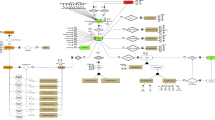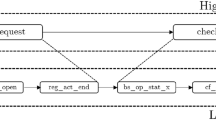Abstract
The quality of knowledge in the knowledge repository determines the effect of knowledge reusing and sharing. Knowledge to be reused should be checked in advance through a knowledge maintenance process. The knowledge maintenance process model is difficult to be constructed because of the balance between the efficiency and the effect. In this paper, process mining is applied to analyze the knowledge maintenance logs to discover process and then construct a more appropriate knowledge maintenance process model. We analyze knowledge maintenance logs from the control flow perspective to find a good characterization of knowledge maintenance tasks and dependencies. In addition, the logs are analyzed from the organizational perspective to cluster the performers who are qualified to do the same kinds of tasks and to get the relations among these clusters. The proposed approach has been applied in the knowledge management system. The result of the experiment shows that our approach is feasible and efficient.










Similar content being viewed by others
References
Agrawal, R., Gunopulos, D., & Leymann, F. (1998). Mining process models from workflow logs. Paper presented at the Proceedings of the Sixth International Conference on Extending Database Technology, Valencia, Spain.
Alavi, M., & Leidner, D. E. (2001). Review: knowledge management and knowledge management systems: conceptual foundations and research issues. MIS Quarterly, 25(1), 107–136.
Bohn, R. (1994). Measuring and Managing Technological Knowledge. Sloan Management Review, 61–73.
Cabac, L., & Denz, N. (2008). Net Components for the Integration of Process Mining into Agent-Oriented Software Engineering. In Jensen Kurt, W. M. P. van der Aalst, & B. Jonathan (Eds.), Transactions on Petri Nets and Other Models of Concurrency I, Lecture Notes in Computer Science, vol. 5100 (pp. 86–103). Berlin: Springer.
Davenport, T. H., & Prusak, L. (1998). Working knowledge: How organizations manage what they know (1st ed.). Boston: Harvard Business School Press.
Edvinsson, L., & Malone, M. (1997). Intellectual capital: Realizing your company's true value by finding its hidden brainpower. NY: Harper Business Publishers.
Grant, R. M. (1996). Toward a knowledge-based theory of the firm. Strategic Management Journal, 17, 109–122.
Hwang, S. Y., & Yang, W. S. (2002). On the discovery of process models from their instances. Decision Support Systems, 34(1), 41–57.
Kane, A. A., Linda, A., & Levine, J. M. (2005). Knowledge transfer between groups via personnel rotation: Effects of social identity and knowledge quality. Organizational Behavior and Human Decision Processes, 96(1), 56–71.
Liao, S. (2003). Knowledge management technologies and applications—literature review from 1995 to 2002. Expert Systems with Applications, 25(2), 155–164.
Mark, G. (1998). Annotate A Web-based Knowledge Management Support System for Document Collections, PhD Thesis, NEW YORK UNIVERSITY, USA.
Nonaka, I. (1990). Managing innovation as a knowledge-creation process: a new model for a knowledge-creating organization. Paper presented at New York University, Stern School of Business, International Business Colloquium
Nonaka, I. (1991). The knowledge-creating company. Harvard Business Review, 69(6), 96–104.
Nonaka, I. (1994). A dynamic theory of organizational knowledge creation. Organization Science, 5, 14–37.
Nonaka, I., & Takeuchi, H. (1995). The Knowledge-Creating Company: How Japanese Companies Create the Dynamics of Innovation, Oxford University Press.
Nonaka, I., & Toyama, R. (2003). The knowledge creating theory revisited: knowledge creation as a synthesizing process, Knowledge Management Research & Practice, 2–10.
Polanyi, M. (1967). The Tacit Dimension. London: Routledge.
Rao, L., & Osei-Bryson, K. M. (2007). Towards defining dimensions of knowledge systems quality. Expert Systems with Applications, 33(2), 368–378.
Rubin,V., Gunther, C.W., van der Aalst,W.M.P., Kindler, E., van Dongen, B.F., & Schafer, W. (2007). Process mining framework for software processes. Paper presented at the Proceedings of the International Conference on Software Processes, Minneapolis, USA.
Song, M., & van der Aalst, W. M. P. (2008). Towards comprehensive support for organizational mining. Decision Support Systems, 46, 300–317.
van der Aalst, W. M. P. (2008). Decision Support Based on Process Mining. In F. B. Clyde & W. Holsapple (Eds.), International Handbooks on Information Systems Handbook on Decision Support Systems 1 (pp. 637–657). Heidelberg: Springer -Verlag.
van der Aalst, W. M. P., van Dongen, B. F., Herbst, J., Maruster, L., Schimm, G., & Weijters, A. J. M. M. (2003). Workflow Mining: a survey of issues and approaches. Data and Knowledge Engineering, 47(2), 237–267.
van der Aalst, W. M. P., & Weijters, A. J. M. M. (2004). Process mining: a research agenda. Computers in Industry, 53, 231–244.
Wang, Y.L., Wang, J., & Zhang, S.H. (2005). Collaborative knowledge management by integrating knowledge modeling and workflow modeling. Paper presented at Proceedings of International Conference on Information Reuse and Integration, Las Vegas, Nevada.
Yang, K. W., & Huh, S. Y. (2008). Automatic expert identification using a text categorization technique in knowledge management systems. Expert Systems with Applications, 34(2), 1445–1455.
Yang, W. S., & Hwang, S. Y. (2006). A process-mining framework for the detection of healthcare fraud and abuse. Expert Systems with Applications, 31(1), 56–68.
Acknowledgement
The research is supported by the National Natural Science Foundation of China under Grant No. 70671007, 70871006, 70901004, the PhD Program Foundation of Education Ministry of China under Contract No. 200800060005 and Research Funds Provided to New Recruitments of China University of Petroleum-Beijing (QD-2010-06).
Author information
Authors and Affiliations
Corresponding author
Rights and permissions
About this article
Cite this article
Li, M., Liu, L., Yin, L. et al. A process mining based approach to knowledge maintenance. Inf Syst Front 13, 371–380 (2011). https://doi.org/10.1007/s10796-010-9287-4
Published:
Issue Date:
DOI: https://doi.org/10.1007/s10796-010-9287-4




